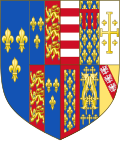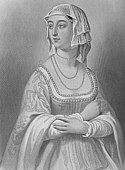Małgorzata Andegaweńska (królowa Anglii)
| Ten artykuł od 2010-06 zawiera treści, przy których brakuje odnośników do źródeł. |
 | |
 | |
| królowa Anglii | |
| Okres | |
|---|---|
| Jako żona | |
| Koronacja | |
| Poprzedniczka | |
| Następczyni | |
| Dane biograficzne | |
| Dynastia | |
| Data urodzenia | |
| Data śmierci | |
| Miejsce spoczynku | 1482, Andegawenia |
| Ojciec | |
| Matka | |
| Mąż | |
| Dzieci | |
Małgorzata Andegaweńska fr. Marguerite d’Anjou (ur. 23 marca 1430, zm. 25 sierpnia 1482) – księżniczka andegaweńska i lotaryńska, królowa Anglii w latach 1445-1461 oraz 1470-1471 jako żona Henryka VI, córka René I Andegaweńskiego i Izabeli Lotaryńskiej.
W 1444 r. zawarto rozejm pomiędzy Anglią i Francją, na mocy którego z inicjatywy króla Francji Karola VII zaręczono córkę jego wasala, Małgorzatę, z Henrykiem VI[1]. 23 kwietnia 1445 w Titchfield w Hampshire odbył się ich ślub.
Zadaniem Małgorzaty było podjęcie starań, aby jej ojciec odzyskał należne mu ziemie położone w Andegawenii, które zostały mu odebrane przez Anglików, jednak Rene I sam tego dokonał w 1450 r. powodując osłabienie pozycji swojej córki[1].
Jedną z najbliższych przyjaciółek i dwórek nowej królowej została Jakobina Luksemburska, której siostra Izabela w 1443 r. poślubiła Karola Walezjusza hrabiego Maine, wuja Małgorzaty[1].
Henryk był królem, odkąd skończył kilka miesięcy (jego ojciec, Henryk V, zmarł młodo) i jego poczynania zawsze kontrolowali regenci. Kiedy poślubiał Małgorzatę, jego stan psychiczny już był „niestabilny”.
Na początku 1453 r. królowa ogłosiła, że jest w ciąży. Króla Henryka VI poinformowała przez posłańca[1]. W połowie 1453 r. stan króla gwałtownie się pogorszył i na rozkaz Małgorzaty przetrzymywano go w komnatach. Sama królowa również przebywała w odosobnieniu oczekując na poród. 13 października 1453 na świat przyszedł Edward Westminster. Henryk VI zgodnie z tradycją powinien uznać publicznie swego syna, jednak po umieszczeniu niemowlaka w jego ramionach w ogóle nie zareagował[1]. Dla jego wrogów było jasne, że Edward nie jest jego synem, ponieważ królowa miała romans z Edmundem Beaufortem, który został jednym z ojców chrzestnych księcia[1].
Pod koniec 1453 r. królowa powróciła do życia politycznego po porodzie i połogu. Podczas niedyspozycji króla i jej nieobecności popularność i wpływy zyskał Ryszard Plantagenet, książę Yorku, który nakazał uwięzić jej kochanka, Edmunda Beauforta[1]. Stan Henryka VI nadal się nie poprawiał. Królowa chcąc zachować władzę i zapewnić koronę swemu nowo narodzonemu synowi, zaproponowała, że zostanie regentką Anglii, jednak ta propozycja nie zyskała akceptacji na dworze[1]. W marcu 1454 r. lordem protektorem ogłoszono Ryszarda Plantageneta, który odesłał króla, królową i małego Edwarda na zamek w Windsorze[1].
Dopiero pod koniec 1454 r. król Henryk VI wyzdrowiał i powrócił do rządów przy jednoczesnej rezygnacji Ryszarda ze stanowiska lorda protektora[1].
Henryk VI zgodził się na odsunięcie syna od tronu i wyznaczył swoim następcą Ryszarda, księcia Yorku. Małgorzata zebrała armię i rozpoczęła walkę z yorkistami. Razem z młodym synem uciekła do Szkocji i Walii, a ostatecznie do Francji. Zawarła przymierze z Ryszardem Neville’em, hrabią Warwick, i książę Edward został zaręczony z córką Warwicka – Anną Neville (późniejszą żoną króla Ryszarda III).
Warwick osadził znowu na tronie Henryka VI. Małgorzata wróciła do Anglii, a wtedy nagle Warwick został pokonany w bitwie pod Barnet i królem został znowu Edward IV. Małgorzata i jej syn zebrali ostatnie wojsko i zostali pokonani w bitwie pod Tewkesbury w 1471 – młody Edward Westminsterski zginął w tej bitwie. Królowa była więziona w Wallingford Castle, a potem w Tower, do czasu kiedy wstawił się za nią król Francji.
Zmarła 25 sierpnia 1482 w rodzinnej Andegawenii, tam też została pochowana.
Przypisy
Media użyte na tej stronie
Autor: Sodacan, Licencja: CC BY-SA 3.0
Arms of Margaret of Anjou. Blason: Parti per pale. Dexter: grand parti per pale, grand dexter: France moderne (for Henry VI as claimant to the throne of France); grand sinister: quarterly 1 and 4 - France moderne, 2 and 3 - England (for Henry VI of England). Sinister: grand parti of six (three over three), i. Barry of eight Argent and Gules (for the Kingdom of Hungary); ii. Azure seme-de-lys Or a label of three points Gules (France ancient a label of three points Gules) (for the Angevin Kingdom of Naples); iii. Argent a cross potent Or cantoned by four crosslets Or (for the Latin Kingdom of Jerusalem); iv. Azure seme-de-lys Or a bordure Gules (France ancient a bordure Gules) (for the County of Anjou); v. Azure crusily fitchy two barbels addorsed Or (for the Duchy of Bar) note: the barbels should be addorsed (dorsal fins toward center); vi. Or a bend Gules three alerions Argent (for the Duchy of Lorraine).
Text from: The Heraldry of Queens’ College, Cambridge By David Broomfield BA (Hons)[1]
The curious agglomeration of quarterings in Margaret’s arms can be traced back to the first House of Anjou. Charles Count of Anjou and Maine (d.1285) was the youngest son of Louis VIII King of France. He conquered the Hohenstaufens and made himself King of Naples and Sicily, he also purchased a claim to the, by then fictional, Kingdom of Jerusalem. King Charles’s arms were those of Anjou (Ancient), France differenced by a red label, and Jerusalem. Charles’s son, Charles II King of Naples married Mary daughter of Stephen V and sister of Ladislaus IV Kings of Hungary. Their eldest son, Charles “Martel”, founded his own line of Kings of Hungary that died out in 1382. Charles and Mary’s daughter Margaret married Charles Count of Valois the son of Philip III King of France. Charles of Naples granted to Charles of Valois the Counties of Anjou and Maine. When Joanna Queen of Naples died she bequeathed the kingdom of Naples to Louis Duke of Anjou. Louis was the great grandson of Margaret of Anjou and Charles of Valois. This the second House of Anjou used the arms of France differenced by a red border, giving us Anjou (Modern). Rene, grandson of Louis I, was Duke of Anjou and Titular King of Naples and Jerusalem and by virtue of his marriage to Isabel of Lorraine he was also Duke of Lorraine and Bar. Queen Margaret was Rene’s daughter. Her arms can be delineated thus: HUNGARY: Barry of eight gules and argent. Though contrary to English heraldry this is how the arms of Hungary were and are shown, the four white bars symbolising the rivers of Hungary. Margaret was descended from Mary sister and heiress of Ladislaus the last King of Hungary of the House of Arpad. Margaret’s father Rene of Anjou, Kings of Naples, always used Barry of eight argent and gules as can be seen from many sources. However, I doubt he ever visited Hungary and his connection with that country was remote but his daughter no doubt took her lead from him when it came to the display of her personal heraldry and passed this on to her College. ANJOU (ANCIENT): Azure semy of fleur de lis or a label of three points gules. These were the arms of the first House of Anjou and borne by Charles d.1285, Count of Anjou, conqueror of Naples and claimant to the throne of Jerusalem. Unfortunately in the painting of the arms in the grant the label is wrongly shown as silver a mistake much repeated about the College. These arms became synonymous with the kingdom of Naples. JERUSALEM: Argent a cross potent between four crosses humetty or. The unique nature of Jerusalem was signified by breaking the cardinal rule of heraldry by placing one metal (gold) on another metal (silver). The cross potent (having flat bars at the ends of the arms) was said to symbolise the letters H and I from “Hierusalem”. Again Cooke’s grant depicts the small crosses between the arms as “potent” while not technically wrong and indeed depicted this way in some Medieval books of arms small plain crosses fit the space better. ANJOU (MODERN): Azure semy of fleur de lis or a border gules. The arms as borne by the second House of Anjou begun by Charles of Valois, Count of Anjou the progenitor of the House of Valois and Naples. BAR: Azure semy of cross crosslets fitchy two barbels hauriant and addorsed. The barbels are clearly punning (or canting) references to Bar. The fish have their heads pointing upwards (as opposed to urinant when their heads are at the bottom of the shield) and addorsed means back to back. The crosses should have a point for the lower arms, some versions at Queens’ have it the same as the other arms. The other usual error is to have a specific number of crosses. “Semy” means that the field is spread with charges and they overlap the edges. Cooke also blazons them as “luces”. In the quarterings used by Rene of Anjou the barbels always grip a cross crosslet fitchy in their mouths. This is well attested in contemporary versions of his arms. In Queens’ they appear thus only once, in the stained glass shield of Queen Margaret’s arms in the Old Senior Combination Room making it likely that these date from the 15th Century. LORRAINE: Or on a bend gules three alerions displayed argent. Alerions are eagles that have neither beaks nor claws. They are best shown with a hole in the middle of the head. It was said that Godfrey of Bouillon (or another) fired an arrow that brought down three birds simultaneously. It is also said that “Alerion” is an anagram of “Lor(r)aine”. In mythology it was said that only two birds existed at any time, they laid a pair of eggs every sixty years and they drowned themselves after hatching. To add to the confusion Cooke describes them as “eagles” and they appear as eagles many times in the
College.


